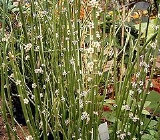
Candelilla
Encyclopedia
Euphorbia antisyphilitica is a species of spurge
that is native to the Trans-Pecos
of Texas
and southern New Mexico
in the United States
as well as Chihuahua, Coahuila
, Hidalgo, and Querétaro
in Mexico
. Common names include Candelilla and Wax Plant, but the latter is more often applied to members of the unrelated genus Hoya
. It is shrub
by and has densely clustered, erect, essentially leaf
less stems that are covered in wax
to prevent transpiration
.
began at the start of the twentieth century, with demand greatly increasing during World War I
and II
. This industry largely disappeared following the end of World War II due to diminished Candelilla populations and the availability of cheaper petroleum-based waxes.
Spurge
Euphorbia is a genus of plants belonging to the family Euphorbiaceae. Consisting of 2008 species, Euphorbia is one of the most diverse genera in the plant kingdom, exceeded possibly only by Senecio. Members of the family and genus are sometimes referred to as Spurges...
that is native to the Trans-Pecos
Trans-Pecos
The term Trans-Pecos, as originally defined in 1887 by the Texas geologist Robert T. Hill, refers to the portion of Texas that lies west of the Pecos River. The term is considered synonymous with "Far West Texas", a subdivision of West Texas...
of Texas
Texas
Texas is the second largest U.S. state by both area and population, and the largest state by area in the contiguous United States.The name, based on the Caddo word "Tejas" meaning "friends" or "allies", was applied by the Spanish to the Caddo themselves and to the region of their settlement in...
and southern New Mexico
New Mexico
New Mexico is a state located in the southwest and western regions of the United States. New Mexico is also usually considered one of the Mountain States. With a population density of 16 per square mile, New Mexico is the sixth-most sparsely inhabited U.S...
in the United States
United States
The United States of America is a federal constitutional republic comprising fifty states and a federal district...
as well as Chihuahua, Coahuila
Coahuila
Coahuila, formally Coahuila de Zaragoza , officially Estado Libre y Soberano de Coahuila de Zaragoza is one of the 31 states which, with the Federal District, comprise the 32 Federal Entities of Mexico...
, Hidalgo, and Querétaro
Querétaro
Querétaro officially Estado Libre y Soberano de Querétaro de Arteaga is one of the 31 states which, with the Federal District, comprise the 32 Federal Entities of Mexico. It is divided into 18 municipalities and its capital city is Santiago de Querétaro....
in Mexico
Mexico
The United Mexican States , commonly known as Mexico , is a federal constitutional republic in North America. It is bordered on the north by the United States; on the south and west by the Pacific Ocean; on the southeast by Guatemala, Belize, and the Caribbean Sea; and on the east by the Gulf of...
. Common names include Candelilla and Wax Plant, but the latter is more often applied to members of the unrelated genus Hoya
Hoya
Hoya is a genus of 200-300 species of tropical plants in the family Apocynaceae , fomerly considered to be in the Asclepiadaceae...
. It is shrub
Shrub
A shrub or bush is distinguished from a tree by its multiple stems and shorter height, usually under 5–6 m tall. A large number of plants may become either shrubs or trees, depending on the growing conditions they experience...
by and has densely clustered, erect, essentially leaf
Leaf
A leaf is an organ of a vascular plant, as defined in botanical terms, and in particular in plant morphology. Foliage is a mass noun that refers to leaves as a feature of plants....
less stems that are covered in wax
Candelilla wax
Candelilla wax is a wax derived from the leaves of the small Candelilla shrub native to northern Mexico and the southwestern United States, Euphorbia cerifera and Euphorbia antisyphilitica, from the family Euphorbiaceae...
to prevent transpiration
Transpiration
Transpiration is a process similar to evaporation. It is a part of the water cycle, and it is the loss of water vapor from parts of plants , especially in leaves but also in stems, flowers and roots. Leaf surfaces are dotted with openings which are collectively called stomata, and in most plants...
.
Uses
The white sap of E. antisyphilitica was historically used in Mexico to treat sexually-transmitted diseases. Commercial harvesting of candelilla waxCandelilla wax
Candelilla wax is a wax derived from the leaves of the small Candelilla shrub native to northern Mexico and the southwestern United States, Euphorbia cerifera and Euphorbia antisyphilitica, from the family Euphorbiaceae...
began at the start of the twentieth century, with demand greatly increasing during World War I
World War I
World War I , which was predominantly called the World War or the Great War from its occurrence until 1939, and the First World War or World War I thereafter, was a major war centred in Europe that began on 28 July 1914 and lasted until 11 November 1918...
and II
World War II
World War II, or the Second World War , was a global conflict lasting from 1939 to 1945, involving most of the world's nations—including all of the great powers—eventually forming two opposing military alliances: the Allies and the Axis...
. This industry largely disappeared following the end of World War II due to diminished Candelilla populations and the availability of cheaper petroleum-based waxes.

